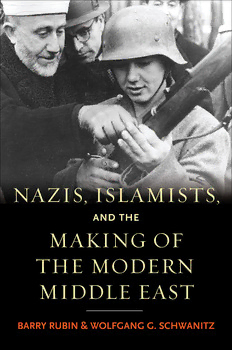
Nazis, Islamists, and the making of the modern Middle East PDF
Preview Nazis, Islamists, and the making of the modern Middle East
Nazis, Islamists, and the Making of the Modern Middle East This page intentionally left blank Nazis, Islamists, and the Making of the Modern Middle East B a r ry ruBi n a n d W o l f g a n g g. S c hW a n i t z new haven & london Archival research by Wolfgang G. Schwanitz for this book was partially made possible by the Education Fund of the Middle East Forum in Philadelphia, Pennsylvania. Copyright © 2014 by Barry Rubin and Wolfgang G. Schwanitz. All rights reserved. This book may not be reproduced, in whole or in part, including illustrations, in any form (beyond that copying permitted by Sections 107 and 108 of the U.S. Copyright Law and except by reviewers for the public press), without written permission from the publishers. Yale University Press books may be purchased in quantity for educational, business, or promotional use. For information, please e-mail [email protected] (U.S. office) or [email protected] (U.K. office). Set in Sabon type by Integrated Publishing Solutions. Printed in the United States of America. Library of Congress Cataloging-in-Publication Data Rubin, Barry M. Nazis, Islamists, and the making of the modern Middle East / Barry Rubin, Wolfgang G. Schwanitz. pages cm. Includes bibliographical references and index. ISBN 978-0-300-14090-3 (hardback) 1. Middle East—Foreign relations—Germany. 2. Germany—Foreign relations—Middle East. 3. National socialism and Islam. 4. World War, 1939–1945—Participation, Muslim. 5. Middle East—History—20th century. I. Schwanitz, Wolfgang G., 1955– II. Title. DS63.2.G4R823 2014 327.43056—dc23 2013028622 A catalogue record for this book is available from the British Library. This paper meets the requirements of ANSI/NISO Z39.48–1992 (Permanence of Paper). 10 9 8 7 6 5 4 3 2 1 To the memory of relatives killed in the Shoah: Dolhinov, Poland: Haya Rubin Perlmutter and Azriel, Haim, and Yaakov Yermiyahu Perlmutter. Shmuel, Rahel Leah, Leah Rivka, Pinkas Leib, Ethel, and Moshe Grosbein. Rahel Dimenshtein and Yirimayahu and Moshe Dimenshtein. Turo, Czechoslovakia: Maria, Jozef, Artur, Ilsa, and Erika Dub —Barry Rubin Dedicated to my parents: Margot Schwanitz and Wolfgang Schwanitz (1929–2013) —Wolfgang G. Schwanitz This page intentionally left blank Contents Preface ix List of Archive Abbreviations xii 1. From Station Z to Jerusalem 1 2. A Christian Imperial Strategy of Islamic Revolution 11 3. A Jihad Made in Germany 32 4. An Islamism Sheltered in Berlin 60 5. Al-Husaini’s Revolt 87 6. The Nazi–Arab/Islamist Alliance Prepares for Battle 109 7. Al-Husaini in Search of an Empire 122 8. Germany’s Muslim Army 144 9. A Bid for Partnership in the Axis 175 10. The War After the War 192 vii viii contents 11. The Arab States’ Useful Nazis 209 12. How the Axis Legacy Shapes Today’s Middle East 233 Notes 255 Index 325 Preface The story of Nazi Germany’s involvement in the Middle East has hitherto largely been viewed as a dramatic tale of might-have-been that was nevertheless marginal to Middle East history and the course of World War II. In fact, however, this episode was central to the modern history of the Middle East and continues to reverberate many decades later given its profound effects on Arab nationalism, Islamism, and the course taken by the Palestinian Arab movement. The recent release by the U.S. government of massive quantities of both wartime and postwar documents coupled with the translation of previously unused German documents and Arabic-language accounts permits a much fuller telling of the story of the interactions among Arabs, Muslims, and Germans. To understand this history requires bringing together several elements. First, there was the German strategy, beginning in the late nineteenth century, that saw Berlin’s interests in the Middle East as being linked to an Islamic jihad against Germany’s European rivals conducted with the help of Muslim organizations. On the other side were radical forces of nationalism and Islamism in rebellion against the regional status quo. These latter groups would become not merely Nazi Germany’s protégés but its partners due to common interests and a set of parallel ideas. This was, then, neither ix
